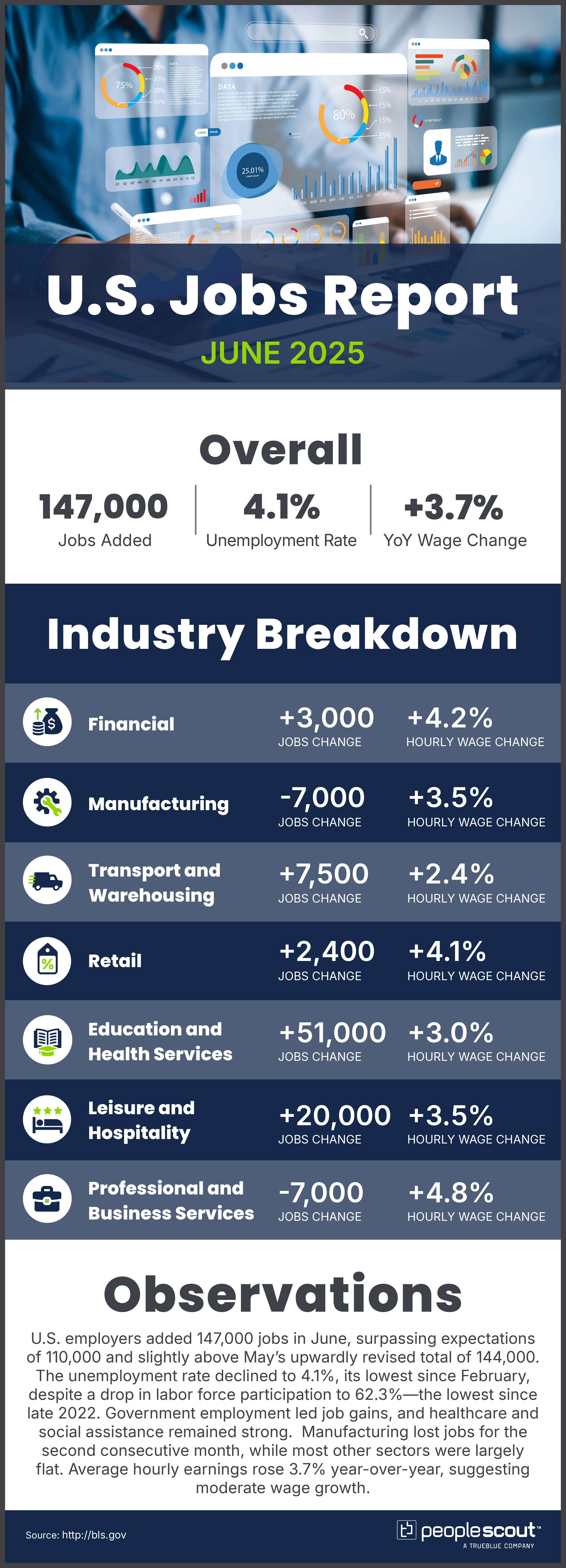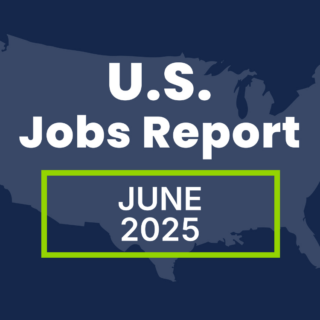U.S. employers added 147,000 jobs in June, surpassing expectations of 110,000 and slightly above May’s upwardly revised total of 144,000. The unemployment rate declined to 4.1%, its lowest since February, despite a drop in labor force participation to 62.3%—the lowest since late 2022. Government employment led job gains, and healthcare and social assistance remained strong. Manufacturing lost jobs for the second consecutive month, while most other sectors were largely flat. Average hourly earnings rose 3.7% year-over-year, suggesting moderate wage growth.

The Numbers
- 147,000: U.S. employers added 147,000 jobs in June.
- 4.2%: The unemployment rate dropped slightly to 4.1%.
- 3.9%: Wages rose 3.7% over the past year.
The Good
June’s headline job growth exceeded forecasts, signaling continued labor market resilience despite economic headwinds. The unemployment rate’s decline to 4.1% is a positive signal, reflecting strong demand for workers in certain sectors. Government hiring, particularly in education and local services, played a significant role, alongside consistent growth in healthcare and social assistance. Wages continued to rise at a steady pace, with a 3.7% year-over-year increase suggesting ongoing competition for talent in key areas. Upward revisions to April and May data further underscore the stability of recent hiring trends.
The Bad
Beneath the surface, signs of cooling are apparent. Private sector hiring slowed sharply to 74,000 jobs in June, down from 137,000 in May, marking the weakest pace in eight months. Manufacturing employment declined by 7,000 jobs for the second month in a row, highlighting persistent challenges in that sector. The labor force participation rate fell to 62.3%, its lowest since late 2022, reflecting an increase in the number of individuals not actively seeking work. The number of long-term unemployed also edged higher, suggesting lingering frictions in the labor market. Additionally, gains in state and local government employment—particularly in education—may be influenced by seasonal or temporary factors, raising questions about their durability.
The Unknown
While June’s job growth exceeded expectations, uncertainties remain around the broader economic outlook. The concentration of gains in public sector and healthcare roles suggests that private-sector momentum may be weakening. Ongoing trade dynamics, geopolitical tensions and shifting business investment patterns continue to create an unpredictable environment for employers. The decline in labor force participation raises questions about worker availability and longer-term labor supply trends. As the Federal Reserve weighs its policy options, June’s mixed signals likely support a continued “wait-and-see” approach rather than immediate action on interest rates.
Conclusion
The June 2025 jobs report highlights a labor market that remains resilient at the headline level but shows emerging signs of softening underneath. Strong gains in government and healthcare hiring supported overall growth, while private-sector job creation slowed considerably. A falling unemployment rate alongside lower labor force participation underscores complex dynamics at play. As organizations navigate this evolving environment, maintaining workforce agility and focusing on targeted talent strategies will be crucial to sustaining business performance in the face of ongoing economic uncertainty.




![[Webinar] Smart Hiring in the AI Age: What UK Candidates Are Really Doing in 2025](https://www.peoplescout.com/wp-content/uploads/2025/05/AI-enable-applicant-report-320x320.jpg)